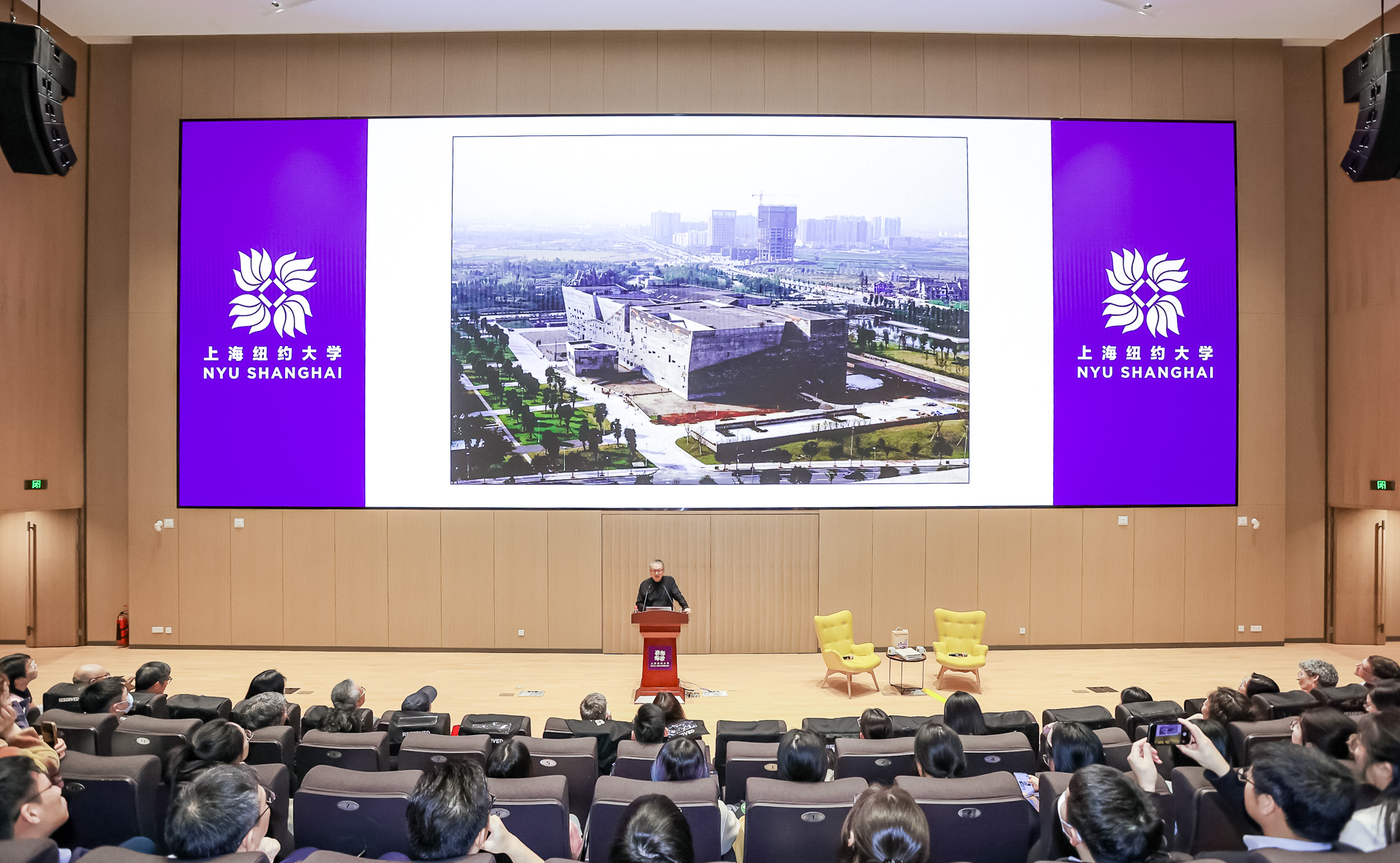Acclaimed architect Wang Shu spoke at NYU Shanghai on November 14 in front of an audience of nearly 600 people, in a lecture touching on the relation between architecture, the passage of time, and human life.
Wang was invited as the second speaker of the NYU Shanghai Green Court Distinguished Lecture Series. Sponsored by the Green Court Foundation, the annual lecture series brings distinguished guests to share their expertise with the University community and the public. NYU Shanghai Vice Chancellor Jeffery Lehman hosted the lecture. Ms. Zhao, vice president of Green Court Capital, delivered the welcome remarks. The series was kicked off last year with a lecture by computer scientist and Turing Award winner John Hopcroft.
Wang and his partner Lu Wenyu are co-founders of their architectural firm, Amateur Architecture Studio, and well respected in the architecture world. “They have developed an architectural language through which contemporary design respects local traditions and craftsmanship, often reusing materials from earlier buildings to connect the present to the past and to connect a building to its surroundings," Vice Chancellor Jeffrey Lehman said in his introduction to Wang.
Born in 1963 in Xinjiang, Wang studied architecture in college and earned his doctor’s degree in architecture and urban planning from Tongji University in 2000. He became the dean of the School of Architecture at China Academy of Art in 2007. In 2012, he became the first Chinese to win the Pritzker Architecture Prize, the highest recognition in the field of architecture. The following year, Wang made Time magazine’s “100 Most Influential People.”
Wang opened his lecture by showing photos of contrasting old and new landscapes, reminding people that urban development should not come at the cost of demolishing historical architecture. He shared that it was those ubiquitous and seemingly small artifacts in old residential areas that inspire him the most. “We must show respect for traces of life and things that have already existed,” Wang said.

Wang showed off his architectural projects that illustrate his vision of architecture, including the Ningbo Historic Museum completed in 2007. Drawing inspiration from the unique construction techniques of rural areas around Ningbo, the museum resembles a fragmented mountain, with its façades created using old bricks, tiles, and shattered pottery pieces discarded during the process of the city's urban development. An advocate and practitioner of the methodology of "rebuilding contemporary Chinese indigenous architecture," Wang said he aims to restore Chinese craftsmanship through modern architecture.
“Nowadays, everything is built in a short amount of time. They all look alike,” he said. “As a result, we gradually lose the sense of time.”
Wang also shared his design for the China Academy of Art’s Xiangshan campus, which was included in The New York Times’ 2021 list of "The 25 Most Significant Works of Postwar Architecture.” He showed the audience what the campus looked like upon completion in 2007, and how it had changed over 15 years as the buildings grew covered with plants.
Wang has even left his imprint on China’s rural revitalization projects. He walked the audience through his design concepts for 14 residential houses in Wencun Village in Fuyang District of Hangzhou. Wang said hewanted to keep what’s important and convenient to locals, so he intentionally left features such as stone steps leading to astream, wider railings on the side of the road for villagers to dry their vegetables, and courtyards often seen in Chinese houses.
“Courtyards are a big part of Chinese culture and in people’s lives," Wang said. “The relationship among architecture, nature, and people is profoundly reflected in the basic architectural form of a courtyard.”
Wang closed out his talk by introducing his new project — China National Archives of Publication and Culture in Hangzhou, inspired by artistic features from the Song Dynasty, including green-glazed celadon ceramics and copper roofing tiles. Lotus flowers and hibiscus, commonly found in Chinese paintings, grow inside the complex, adding a touch of elegance to the space.

During the Q&A session, Wang addressed audience questions on topics including balancing historical preservation and urban development and how to make NYU Shanghai’s campus more integrated with nature.
Wang closed with an argument for the importance of architecture over time. “Architecture actually does change and grow. People, through their frequent interactions with buildings, can learn to appreciate, understand, and even participate in this process of change. Architects therefore must learn to examine those changes over time in a more subtle, humanistic way.”


